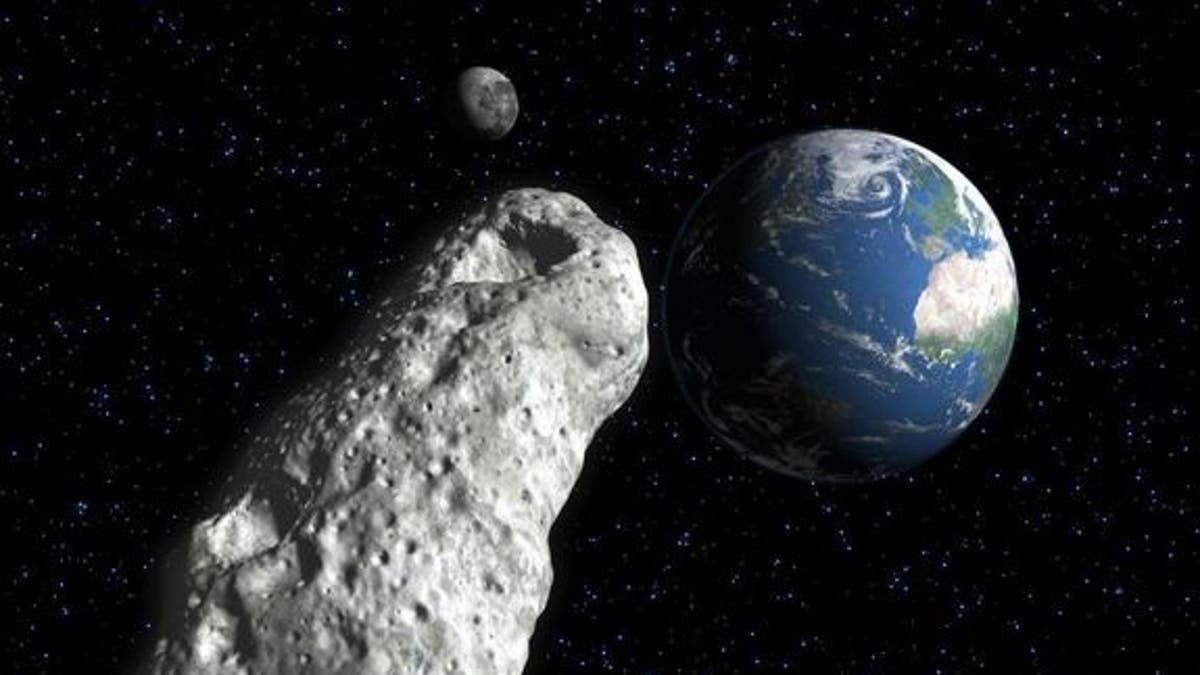
A football-sized asteroid – labeled 2018 GE3 – buzzed by Earth on April 16, 2018. (Texas A&M)
An asteroid the size of a football field buzzed by Earth Sunday in one of the closest encounters the planet has seen in a while.
At its closest point, the asteroid – called 2018 GE3 – was just 119,500 miles away from Earth's atmosphere, about half the distance between Earth and the moon, according to NASA's Center for Near Earth Object Studies (CNEOS). The estimated diameter of the space rock ranged from 131 to 328 feet, CNEOS reports.
That's nothing compared to asteroids that make up the asteroid belt between Mars and Jupiter, which can measure to about 580 miles across, NASA explains on its website. Those asteroids, however, pose no threat to Earth.
The 2018 GE3 asteroid was discovered just one day before it skimmed past Earth in what scientists are calling a "surprise" flyby.
"2018 GE3 was discovered by the Catalina Sky Survey approaching Earth on April 14th. Hours later, amateur astronomer Michael Jäger of Weißenkirchen Austria video-recorded the space rock gliding through the southern constellation Serpens," Spaceweather.com reported.
WHY NASA IS SENDING A SPACECRAFT TO A METAL ASTEROID CALLED 'PSYCHE'
The asteroid that flew by Earth Sunday was up to six times the size of the meteor that exploded over Russia's Ural Mountains in Chelyabinsk back in February 2013.
That meteor – estimated to be about 10 tons and 49 feet wide – entered the Earth's atmosphere at a hypersonic speed of at least 33,000 mph and shattered into pieces about 18-32 miles above the ground, injuring 1,100 people (mostly from flying glass), the Russian Academy of Sciences confirmed.
"It might make you feel better (or worse) to know that asteroids enter Earth’s atmosphere unnoticed on a fairly regular basis."
"It doesn’t take a very large object. A 10-meter size object already packs the same energy as a nuclear bomb," Andrew Cheng, who led a 2000-2001 mission for NASA to orbit and land on an asteroid, told Fox News at the time.
The April asteroid, however, traveling at a speed of about 66,000 miles per hour, would have likely broken down "due to friction with the air" as soon as it entered Earth's atmosphere, EarthSky reported.
MINING FOR ASTEROIDS WILL BE THE NEXT GOLD RUSH
"However, some of an asteroid this size might have gotten through to Earth’s surface, and an asteroid this big is capable of causing some regional damage, depending on various factors such as composition, speed, entry angle, and location of impact," the space website explains. "It might make you feel better (or worse) to know that asteroids enter Earth’s atmosphere unnoticed on a fairly regular basis."
NASA tracks asteroids that make close approaches to Earth, providing data on the distance and estimated diameter of each object. At least three other small space rocks are set to fly past Earth on Tuesday – with the largest measuring 111 feet around.
That's significantly smaller than the 2018 GE3 asteroid.
"A preliminary analysis of the orbit of 2018 GE shows this is the closest this particular space rock has come to Earth at least since 1930," EarthSky reports.
The Associated Press contributed to this report.




















